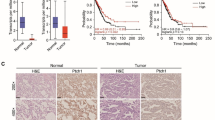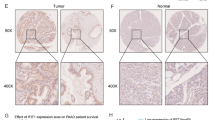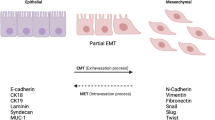Abstract
Transforming growth factor beta (TGF-β) induces epithelial–mesenchymal transition (EMT) accompanied by cellular differentiation and migration. Despite extensive transcriptomic profiling, identification of TGF-β-inducible, EMT-specific genes during metastatic progression of lung cancer remains elusive. Here, we functionally validate a previously described post-transcriptional pathway by which TGF-β modulates expression of interleukin-like EMT inducer (ILEI), and EMT itself. We show that poly r(C)-binding protein 1 (PCBP1) binds ILEI transcript and repress its translation. TGF-β activation leads to phosphorylation at serine-43 of PCBP1 by protein kinase Bβ/Akt2, inducing its release from the ILEI transcript and translational activation. Modulation of hnRNP E1 expression modification altered TGF-β-mediated reversal of translational silencing of ILEI transcripts and EMT. Furthermore, ILEI could induce, as well as maintain, CD24lowCD44high subpopulation in A549 cells treated with TGF-β, which might explain its capability to induce metastatic progression. These results thus validate the existence of an evolutionary conserved TGF-β-inducible post-transcriptional regulon that controls EMT and subsequent metastatic progression of lung cancer.




Similar content being viewed by others
References
American Cancer Society. Global cancer facts and figures. 2nd ed. 2008. p15. http://www.cancer.org/acs/groups/content/@epidemiologysurveilance/documents/document/acspc-027766.pdf. Accessed 10 Sep 2012.
World Health Organization. Cancer fact sheet. http://www.who.int/mediacentre/factsheets/fs297/en/. Accessed 10 Sep 2012.
Van ZN. Neoadjuvant strategies for non-small cell lung cancer. Lung Cancer. 2001;34:s145–50.
Xiao DK, He JX. Epithelial mesenchymal transition and lung cancer. J Thorac Dis. 2010;2:154–9.
Thiery JP, Sleeman JP. Complex networks orchestrate epithelial–mesenchymal transitions. Nat Rev Mol Cell Biol. 2006;7:131–42.
Peinado H, Olmeda D, Cano A. Snail, Zeb and bHLH factors in tumor progression: an alliance against the epithelial phenotype? Nat Rev Cancer. 2007;7:415–28.
Chaudhury A, Hussey GS, Ray PS, Jin G, Fox PL, Howe PH. TGF-beta-mediated phosphorylation of hnRNP E1 induces EMT via transcript-selective translational induction of Dab2 and ILEI. Nat Cell Biol. 2010;12:286–93.
Evdokimova V, Tognon C, Ng T, Ruzanov P, Melnyk N, Fink D, et al. Translational activation of snail1 and other developmentally regulated transcription factors by YB-1 promotes an epithelial–mesenchymal transition. Cancer Cell. 2009;15:402–15.
Warzecha CC, Shen S, Xing Y, Carstens RP. The epithelial splicing factors ESRP1 and ESRP2 positively and negatively regulate diverse types of alternative splicing events. RNA Biol. 2009;6:546–62.
Hussey GS, Chaudhury A, Dawson AE, Lindner DJ, Knudsen CR, Wilce MC, et al. Identification of an mRNP complex regulating tumorigenesis at the translational elongation step. Mol Cell. 2011;41:419–31.
Petz M, Kozina D, Huber H, Siwiec T, Seipelt J, Sommergruber W, et al. The leader region of Laminin B1 mRNA confers cap-independent translation. Nucleic Acids Res. 2007;35:2473–82.
Waerner T, Alacakaptan M, Tamir I, Oberauer R, Gal A, Brabletz T, et al. ILEI: a cytokine essential for EMT, tumor formation, and late events in metastasis in epithelial cells. Cancer Cell. 2006;10:227–39.
Gregory PA, Bert AG, Paterson EL, Barry SC, Tyskin A, Farshid G, et al. The miR-200 family and miR-205 regulate epithelial to mesenchymal transition by targeting ZEB1 and SIP1. Nat Cell Biol. 2008;10:593–601.
Korpal M, Lee ES, Hu G, Kang Y. The miR-200 family inhibits epithelial–mesenchymal transition and cancer cell migration by direct targeting of E-cadherin transcriptional repressors ZEB1 and ZEB2. J Biol Chem. 2008;283:14910–4.
Park SM, Gaur AB, Lengyel E, Peter ME. The miR-200 family determines the epithelial phenotype of cancer cells by targeting the E-cadherin repressors ZEB1 and ZEB2. Genes Dev. 2008;22:894–907.
Wu X, Piper-Hunter MG, Crawford M, Nuovo GJ, Marsh CB, Otterson GA, et al. MicroRNAs in the pathogenesis of Lung Cancer. J Thorac Oncol. 2009;4:1028–34.
Hussey GS, Link LA, Brown AS, Howley BV, Chaudhury A, Howe PH. Establishment of a TGF-β-induced post-transcriptional EMT gene signature. PLoS ONE. 2012;7:e52624.
Wildey GM, Patil S, Howe PH. Smad3 potentiates transforming growth factor β (TGF-β)-induced apoptosis and expression of the BH3-only protein Bim in WEHI 231 B lymphocytes. J Biol Chem. 2003;278:18069–77.
Hocevar BA, Brown TL, Howe PH. TGFβ induces fibronectin synthesis through a c-Jun N-terminal kinase-dependent, Smad4-independent pathway. EMBO J. 1999;18:1345–56.
Mani SA, Guo W, Liao MJ, et al. The epithelial–mesenchymal transition generates cells with properties of stem cells. Cell. 2008;133:704–15.
Thomson S, Buck E, Petti F, Griffin G, Brown E, Ramnarine N, et al. Epithelial to mesenchymal transition is a determinant of sensitivity of non-small-cell lung carcinoma cell lines and xenografts to epidermal growth factor receptor inhibition. Cancer Res. 2005;65:9455–62.
Tauler J, Zudaire E, Liu H, Shih J, Mulshine JL. hnRNP A2/B1 modulates epithelial–mesenchymal transition in lung cancer cell lines. Cancer Res. 2010;70:7137–47.
Reya T, Morrison SJ, Clarke MF, Weissman IL. Stem cells, cancer, and cancer stem cells. Nature. 2001;414:105–11.
Behbod F, Rosen JM. Will cancer stem cells provide new therapeutic targets? Carcinogenesis. 2005;26:703–11.
Dean M, Fojo T, Bates S. Tumor stem cells and drug resistance. Nat Rev Cancer. 2005;5:275–84.
Conflicts of interest
None
Author information
Authors and Affiliations
Corresponding author
Additional information
Qi Song and Wei Sheng are co-first authors.
Rights and permissions
About this article
Cite this article
Song, Q., Sheng, W., Zhang, X. et al. ILEI drives epithelial to mesenchymal transition and metastatic progression in the lung cancer cell line A549. Tumor Biol. 35, 1377–1382 (2014). https://doi.org/10.1007/s13277-013-1188-y
Received:
Accepted:
Published:
Issue Date:
DOI: https://doi.org/10.1007/s13277-013-1188-y




